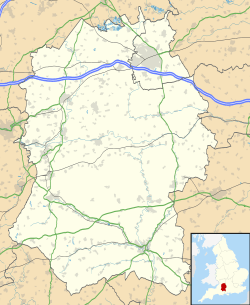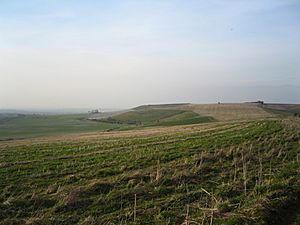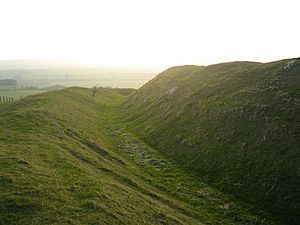Liddington Castle facts for kids
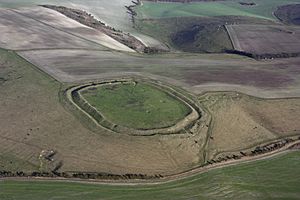
Aerial photograph of Liddington Castle
|
|
| Alternative name | Liddington Camp |
|---|---|
| Coordinates | 51°30′57″N 1°42′01″W / 51.51584°N 1.70020°W |
| OS grid reference | SU209797 |
| Altitude | 277 m (909 ft) |
| Part of | The Ridgeway |
| Area | 3 hectares (7.4 acres) |
| History | |
| Founded | 7th Century BC |
| Periods | Late Bronze Age and Iron Age |
| Site notes | |
| Excavation dates | 1976 |
| Public access | yes |
| Designation | Scheduled Monument Number 1016312 |
Liddington Castle, also known as Liddington Camp, is an ancient hill fort in Wiltshire, England. It was built a very long time ago, during the late Bronze Age and early Iron Age. This type of fort is called a univallate hill fort, meaning it has one main bank and ditch.
Standing at 277 metres (909 ft), it is the highest point in the Borough of Swindon. The fort is located on a high spot near The Ridgeway, an ancient path. It covers an area of about 3 hectares (7.4 acres).
Liddington Castle is one of the oldest hill forts in Britain. People first lived here around the 7th century BC. The fort's defenses were made of a simple oval bank of timber and earth, with a ditch in front. There were two entrances, one on the east and one on the west.
Later, the western entrance was blocked. The eastern entrance might have been lined with large sarsen stones. A fence of wooden posts, called a palisade, probably stood on top of the bank. Over time, the bank and ditch were made even stronger. Workers dug out more chalk from the ditch, making the bank taller and tougher.
Contents
Discovering the Past
Early Finds
Between 1896 and 1900, people were digging for flint at Liddington Castle. During this time, many old objects made by humans were found. These items were collected and later placed in the Ashmolean Museum. These finds helped us learn more about the people who lived there long ago.
What Did Excavations Show?
In 1976, archaeologists dug up parts of the hill fort. They found a large pit, about 1.5 metres (4 ft 11 in) wide and at least 2.4 metres (7 ft 10 in) deep. The bottom of this pit was never reached. The archaeologists thought it might have been a ritual shaft, used for special ceremonies. Similar shafts have been found at other ancient sites in Britain.
The excavations also showed that the fort's main bank, called a rampart, was built in four stages. The last stage might have been during the Saxon period, much later than the original fort. Pottery found at the site suggests that Liddington Castle was left empty around the 5th century BC. However, some people might have returned to live there during the Roman period. Four pieces of human bone were also found during the dig.
Legends and History
Mount Badon Connection
Some people think Liddington Castle might be the famous Mount Badon. This is a place mentioned in old stories where a big battle, the Battle of Mount Badon, supposedly happened around the late 5th century AD. This battle is linked to the legendary King Arthur.
However, there is no archaeological proof that people were active at Liddington Castle during that later period. So, while it's an interesting idea, it remains a legend.
Liddington Castle in Modern Times
World War II Role
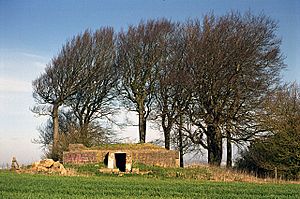
During World War II, the area around Liddington Castle was used as a Starfish site. This was a clever trick to fool enemy bombers. It was designed to look like a burning town or city from the air, drawing bombs away from real towns.
You can still see signs of this today. There's a control bunker about 1 kilometre (0.62 mi) north-east of the fort. There's also a metal trough that was used to create fake explosions and fires.
Richard Jefferies' Inspiration
Liddington Castle was a special place for Richard Jefferies, a local writer who loved nature and rural life. He spent a lot of his free time walking on the wide chalk hills of the Marlborough Downs.
It was on this very hill that he wrote in his book, The Story of My Heart, about how his deep connection to nature started to give him a powerful inner feeling. He felt a desire for a bigger existence or reality while on this ancient hill.
Images for kids


